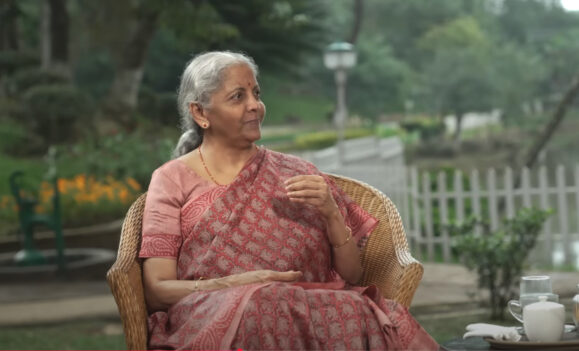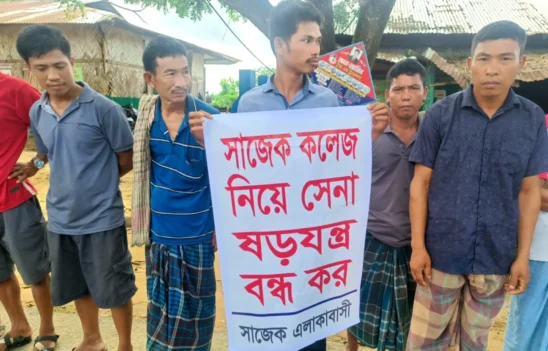Vibrant and diverse in essence
Arunachal Pradesh is home to diverse indigenous communities with distinct languages, cultures, traditions and socio-religious practices. Arunachal Pradesh or the north-east at large is often looked upon as a monolithic block by the rest of India, but we are as diverse as it can get. It is in fact, a microcosm of Indian diversity. Growing up in Arunachal endows one with the privilege of not just being a part of a diverse home of indigenous communities, but its socio-political history has enabled it to be a melting pot of different people from different parts of the country.
People here celebrate Diwali with as much fervour as Christmas. It is very common for one to be invited to a sumptuous Onam, Eid or Bihu meal by one or the other neighbours. Perhaps this elucidates the uncaged character of our taste buds, that doesn’t limit itself to like only a specific variety of palate. People here are open to explore and show much enthusiasm in different delectables as varied as Dosa from Kerala, sweets from Rajasthan to numerous varieties of ‘street food’ category. No wonder many businessmen from across the country find the place lucrative enough to established their restaurants and eateries.
Why do we eat what we eat?
So much of what people eat is guided and determined by a complex set of factors. It is shaped by an intersection of culture, religion, heritage and more simply, by the topography and the unique eco-system people find themselves to be a part of. Food habits and tastes are therefore not as independent a choice as we assume it to be. Respect for different cultures, food habits and practices emanates from a common-sensical understanding of this basic fact. The society here gives space to exercise one’s agency in choosing one’s dietary habits and tastes; without policing what is on someone else’s plate.
Random pick from a multitude
The state has an interesting trail of local platters, unique in its ingredients and preparation depending on the region. This capacitates the state to offer a diverse and dynamic menu. The local preparations are predominantly non- vegetarian, along with a huge portion of exotic green herbs in every serving. Traditionally, almost all preparations do not involve deep frying or oily concoctions. The local dishes might often be described as “bland” by someone tasting it for the first time, but for those who’ve developed a taste for it, it is distinct with myriad notes of flavours.
To bust a major misconception, momo/dumpling is not quite a staple here. People love and devour it, as much as many other non-local dishes that have made its way to people’s platter and heart. The staple here is the simplest and easiest preparation of steamed rice. The locals grow different varieties of paddy, through two major methods- Jhum cultivation and terrace farming. Increasingly, people specially in the capital, have started consuming rice varieties like Basmati or diabetic sugar-free rice that come from outside the state.
Here are a few assortment of delectables from the beautiful ‘land of the dawn lit mountains’:
Butter tea : Also known as Tsa-Jha or Boi-Jha in the local Monpa dialect, it is a signature beverage from the beautiful district of Tawang. It is prepared with a specific mix of yak butter, salt, water and tea leaves. Butter made from cow’s milk is also used lately, due to decrease in yak rearing for multitude of reasons ranging from climate change to modernisation of traditional life. All the same, one cannot describe in words the comfort that a warm, creamy cup of butter tea offers amidst the chilly and picturesque setting of Tawang — a must-have to complete the Tawang experience.
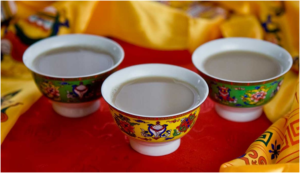
Zan: Arunachal Pradesh is home to different varieties of millet. Another favourite from Tawang, Zan is a finger millet porridge mixed with select vegetables (spinach, pea, carrot etc). It is not only filling but also loaded with protein; a delicious blend for taste and health. No wonder, it is a breakfast favourite among the Monpas.
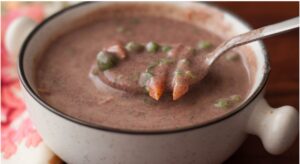
Amin: Amin is a rice congee, cooked in a mix of chicken stock with chicken shreds and seasoned with scallions, grated ginger-chilli and a pinch of dried bamboo shoot. It forms a quintessential dish among the Galo people. This dish is associated with the harvest festival ‘Mopin’, where it is prepared as a major celebratory dish signifying auspiciousness and prosperity. It is prepared in almost all celebratory functions, from birth of a child to a house warming party. Although it can be prepared with any rice variety, the original taste is brought out by local rice varieties rich in carbohydrates. If you attend a Galo celebration, do not forget to ask, “where’s the Amin?”.

Luktir: It is a spicy mixture of chilli flake, Sichuan pepper, garlic, ginger, dried bamboo shot and dry fried meat. It is served as a side dish and its long shelf life makes it even more ubiquitous in every household. Local entrepreneurs have made it easily available in local and online market sites. For students staying away from the state, it is a pack of nostalgia reminding one of home and one’s roots. Since it is preservable for a few months, it is also popularly shared and gifted as a token of love to neighbours, relatives and friends, much like a bottle of “Ghar ka Achar” does for many of us in other parts of the country.
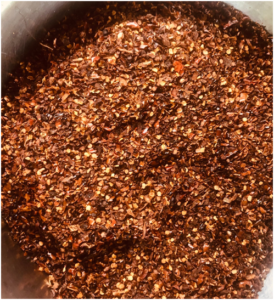
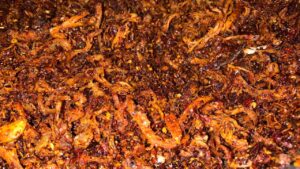
Pike-Pila: It is a traditional dish of the Apatani people from Ziro Valley. The most important ingredient of this preparation is ‘Pila’ which is a dark brown liquid with a strong astringent smell. Edible plant peel (typically banana stem) are sun dried, charred and water dipped; the filtered liquid extract is called ‘Pila’. It is then mixed with preserved pork fat and cooked with fermented bamboo-shoot, along with smoked meat, chilli, local vegetables and spices. The Pila gives an earthy flavour and the rest of the ingredients together presents a glorious savoury taste; appetizing and flavoursome.
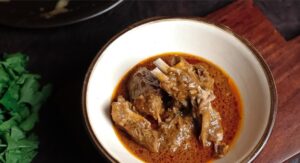
Smoked and roasted meat : If there is one common preparation that is aced and relished the same way across communities, it is roasted and smoked meat. It is an indispensable, pretty much like a ritual, for every jolly gathering and celebration. A fun friend’s night, picnics, new year celebration or just a private family gathering cannot go without roasting and homemade dips for it, especially during winters.
Smoked meat which is prepared by slowly heating and turning the meat kept above the fireplace for days was something that our ancestors devised to preserve and stock meat. But even today, inspite of other numerous modern methods of preservation, smoked meat is irreplaceable. While some still use it as a preservative method, to others, it is the specific taste, the smoky smell and the inherent sentimentality for tradition that it evokes that draws them to continue making it a part of one’s platter. If one is to describe winters here, it is a platter of roasted meat, a pint of rice bear, slow music, crackling fireplace and a jolly gathering around it; living life one moment at a time.
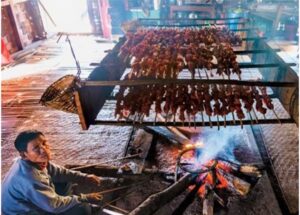
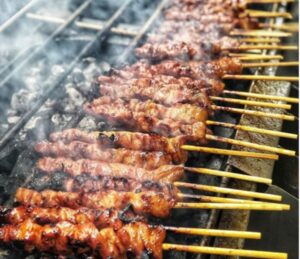
Bamboo-shoot : Any discussion on Arunachali food habit and cuisine is incomplete without apportioning a space for bamboo-shoot. Bamboo plant occupies a sacrosanct place in the lives of the indigenous communities in the state. It is not only used for consumption, but it sees an irreplaceable use in religious events like making of the alter for animal sacrifice to building houses or objects of everyday use.
As a food item, as the name suggests, it is the tender whitish shoot which is consumed not the hardened, matured green bamboo! The shoot is eaten fresh during season and preserved as fermented bamboo shoot for the remaining year till the next season. When it is readily available, the fresh and tender shoot is shredded and pressure cooked till is softened. It is then stir fried and flavoured with chilli flakes and other spices. The distinct taste of tender shoot, its crispy yet soft texture coupled with spices and seasonings is simply mouth watering.
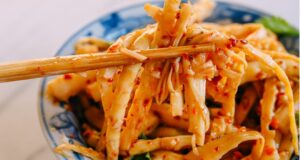
Indigenous people are known to have lived in harmony with nature dating back as far as history can traverse. In spite of rapid modernisation, urbanisation and industrialisation uprooting indigenous ways of life through its vicious claws, some practices are still held and preserved with grit. These rice packings, wrapped in ‘Ekkam’ leaves in Galo dialect (scientific name: Thaumatococcus Danielle), is used for packaging food.
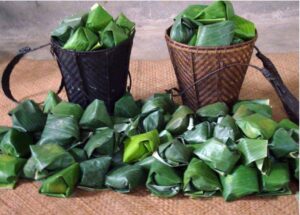
This leaf is found in the wild and can also be grown in one’s backyard. The practice of using it as a packaging material and a serving plate is a strong cultural practice. It is not seen with disdain or embarrassment, but rather with a sense of pride even amongst the younger generation. In festive gatherings and celebration or even in day to day life, it is used as an eco-friendly, bio-degradable alternative to disposable plastic cups and plates. For the indigenous community, it is a subtle reminder of our history of harmonious existence with nature; a call to mend our relations before its too late to calm nature’s fury.




